Mt. Wutai, known as ''the roof of North
China'' and the most holy land of Chinese Buddhism,
is situated in Wutai County in Xinzhou Region of Shanxi
Province. It covers an area of 2,837 square kilometers
with the average altitude over 1,000 meters.
It is rated the first group of national scenic spots
and the top 10 scenic spots in Shanxi province. It is
as famous as Mt. Emeishan in Sichuan Province, Mt. Putuoshan
in Zhejiang Province, and Mt. Jiuhuashan in Anhui Province,
all of which are renowned as the four sacred Buddhist
Mountains. And the nature gives Mt. Wutai the soul and
it makes Mt. Wutai a masterpiece work. Its predominantly
beautiful sceneries are the Wanghai Peak in the east,
Guayue Peak in the west, Jinxiu Peak in the south, Yedou
Peak in the north, and the central Cuiyan Peak.
Mt. Wutai is a showcase of classical Chinese architecture,
sculpture and painting. In addition, Mt. Wutai International
Tourist Month is a major tourist event, which takes
place annually from July 25 to August 25. And if you
can visit Mt. Wutai during July and August, you will
have the privilege of witnessing something truly unique.
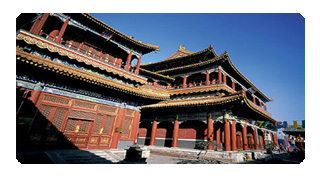 Tayuan
Temple
Tayuan
Temple
During the reign of Emperor Wanli of the Ming Dynasty
a large sarira dagoba was constructed in Tayuan Temple.
The temple was designed with the sarira dagoba as the
center, with the main hall in the front and the Buddhist
scripture chamber (library) at the back. The dagoba
was surrounded by balustrades and a courtyard was attached
to it in the east. The whole design was neat and well
balanced.
It is a Lamaist dagoba on a square base, composed of
a huge Sumem pedestal, an inverted-bowl body, and a
thirteen-tier steeple crowned by a canopy, a crescent
moon and a precious bead. Fifty meters high, it is one
of the tallest Lamaist dagobas. The dagoba is brick
inside and coated with white lime outside, so it is
also called the White Dagoba, a landmark of Mount Wutai.
The canopy, crescent and bead on the top, all made of
copper and gilded, glitter bright under the sunlight.
There are 252 little bells hanging from the umbrella-shaped
canopy and around the middle of the dagoba, adding special
charm when they jingle in the wind.
The construction of Tayuan Temple was recorded on a
stone tablet dating back to July 1582 during the reign
of Emperor Wanli of the Ming Dynasty. The record was
composed by the prime minister, Zhang Juzheng. It provides
valuable data for studying the construction of the dagoba.
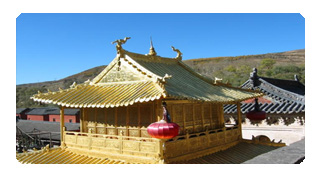 Xiantong
Temple
Xiantong
Temple
The Xiantong Temple is located in the north of Taihuai
Town, Wutai Mountain, Shanxi Province.
Wutai Mountain in Shanxi Province is one of the most
famous five Buddha locations in China and the largest
and oldest one of the five. The Xiantong Temple, originally
named Dafulinjiu Temple, was first built in the Yongping
reign of the Eastern Han Dynasty (25-220). It is the
ancestor Buddhist temple in Wutai Mountain. According
the History of Qingliang Mountain, Emperor Xiaowen
of the Northern Wei Dynasty (386-534) rebuilt it and
expanded it into twelve courtyards, with a garden
in the front, so it was also called Garden Temple.
It is renamed to the Great Huayan Temple in the reign
of Wu Zetian in the Tang Dynasty (618-907). The temple
was further expanded in the period of the Sui (581-618)
and Tang Dynasties, and twelve courtyards were built
around the temple with pagodas in the front. It was
reconstructed by Emperor Taizu in the early years
of the Ming Dynasty (1368-1644), and was conferred
a stele that reads the Great Xiantong Temple by the
emperor. It was after the repair in the Qing Dynasty
(1644-1911) that it formed the large scale we see
today.
The temple has an area of 80,000 square meters with
more than 400 constructions of different types, most
of which were built in the Ming and Qing Dynasties.
There are chains of mountains and old cypresses around
the temple. Taking up an area of more than 8 hectares,
the constructions have a compact layout. There are
seven halls in the axis, respectively, the Kwan-yin
Hall, the Bodhisattva Hall, the Great Buddha Hall,
the Wuliang (Amita) Hall, the Qianbo Wenshu Hall,
the Copper Hall, and the Sutra Storing Hall. All types
of constructions are located on both sides of the
axis, such as wing-rooms, side halls, stalls, meditation
rooms, abbot courtyard houses, and monks' rooms, altogether
more than 300 rooms. The Great Buddha Hall has a double-eave
gable and hip roof, with corridors around and inward
shrinkage in the corners. The front eaves are decorated
with patterns of dragon and phoenix, with beautiful
shape and skillful engraving.
Because the Xiantong Temple is the largest and oldest
temple among the temples in Wutai Mountain, it is
also called the Ancestor Temple. Pilgrims usually
pay a formal visit to the Xiantong Temple first.
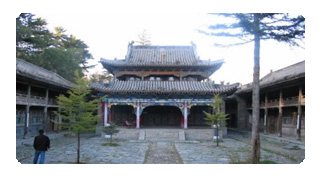 Cifu
Temple
Cifu
Temple
Cifu Temple with secluded and very spiritual is the
excellent examples of Tang and Song Dynasty temples.
The temple locate at the south of Zixia valley of
Pulong hill with the layout in long riband. It was
originally built in the year of Daoguang in Qing Dynasty,
and it's one of the most special of construction style
in the temples of Wutaishan. Total covers 7,800 square
meters and place the 80 rooms in it.
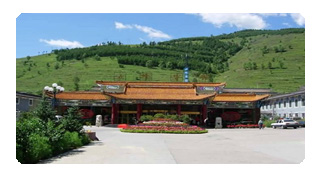 Nanshan
Temple
Nanshan
Temple
This temple was first built during the Yuan Dynasty
(1271-1368), and is comprised of seven different terraces,
subdivided into three parts. The Jile Temple hosts
the lower three terraces, with the Shande Hall encompassing
the middle terrace, and the remaining three terraces
are included in the Yanghuo Temple on the upper terrace.
Other Temples on the mountain include Luohou Temple,
Guangren Temple, and Shuxiang Temple.
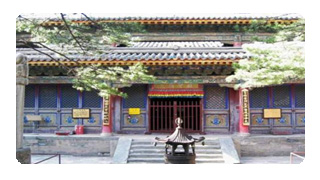 Shuxiang
Temple
Shuxiang
Temple
Shuxiang Temple is the southwest neighbor of Tayuan
Temple. Built in Yuan Dynasty(1271-1368), it covers
6,400 square meters, and encompasses over 50 places
and halls. Among them Manjusri Pavilion is the largest
one in the center of the Taihuai Country, with Majusri
Bodhisattva's statue in it. A clear spring flows out
of the temple named "Banruo" or "Parjna",
meaning "adding wisdom", whose water was
used in the courts.
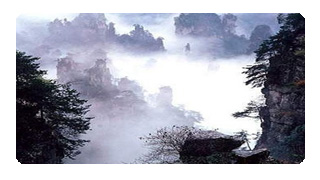 Mt.
Wutaishan
Mt.
Wutaishan
Mt. Wutaishan, an important Buddhist mountain with
superb natural conditions, is home to over 600 kinds
of plants, of which more than 150 are used as rare
herbs. There is also a local product that can be found
on this mountain, Taimo, a type of mushroom with high
nutritional value. On the mountain, many artworks
have been preserved due to the plethora of temples
found here. Among the temples on the mountain, Foguang
Temple and Nanchan Temple have the longest history.



